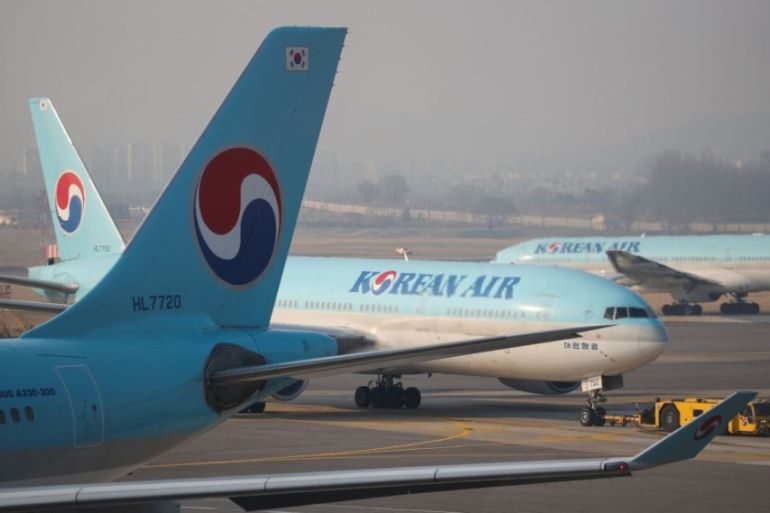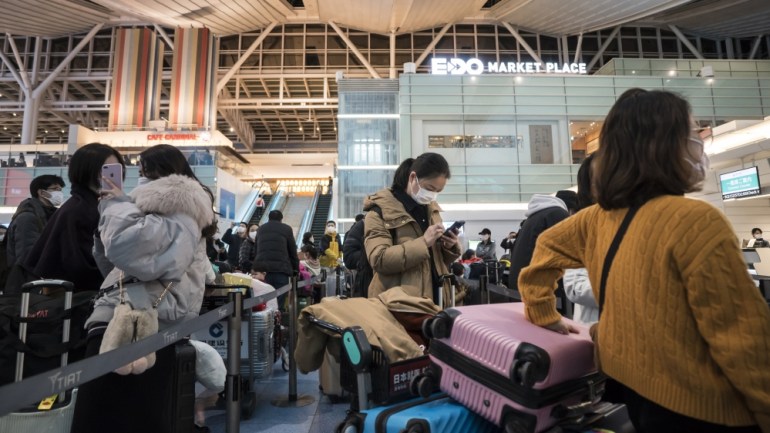Asia holds tight on borders, casting cloud over COVID-hit travel
Countries such as Japan, South Korea and Malaysia take middle path on reopening, with travel still heavily restricted.

Hwaseong, South Korea – Asia-Pacific countries are sticking to tight border controls even as vaccination rates top out, dampening prospects for a revival of the region’s pandemic-battered travel industry.
While mainland China and Hong Kong sink deeper into isolation under a strict “zero COVID” policy that mandates weeks of hotel quarantine, countries such as Japan, South Korea, Australia, Singapore and Malaysia are following a middle path under which non-essential travel remains tightly restricted.
Keep reading
list of 4 itemsThousands protest in New Zealand against compulsory COVID jabs
Covaxin, India’s homegrown COVID jab, ‘highly efficacious’: Study
COVID-19’s epicentre again: Europe faces fresh reckoning
The region’s cautious stance is increasingly at odds with Europe and North America, where vaccinated travellers, including tourists, can travel freely with few restrictions apart from a negative COVID test result.
“Asia still has a long way to go to catch up with the reopening taking place in Europe and North America,” Jayant Menon, a visiting senior fellow at the ISEAS-Yusof Ishak Institute in Singapore, told Al Jazeera.
“Some of this is explained by the need to also catch up with their vaccination rates, but not all. Even countries with high vaccination rates … are not opening their international borders as quickly as they are easing domestic mobility restrictions. And when they do, they impose a lot more requirements and protocols than those applied to domestic movement.”

Japan and South Korea, where vaccination rates are approaching 80 percent, have yet to announce a date for the resumption of tourism despite easing restrictions for certain arrivals such as business travellers and students.
Australia, where about 70 percent of the population is double-vaccinated, has indicated that international tourists won’t return until sometime next year.
Malaysia, where 77 percent of residents are double-jabbed, remains largely closed to international arrivals, with plans to begin accepting international tourists by January.
Singapore, where more than 80 percent of the population has had two doses of vaccine, has resumed quarantine-free travel in phases through a vaccinated travel lane scheme, which from next month will include 21 countries.
Arrivals to most of Asia were down 99 percent on pre-pandemic levels as of September, compared with declines of just 20 percent in Mexico and about 65 percent for Southern Europe, according to figures compiled by Capital Economics.
Before the pandemic, the Asia-Pacific welcomed about 291 million tourists annually, adding $875bn to the economy, according to the World Economic Forum’s Travel & Tourism Competitiveness Index 2019.
‘Three-speed recovery’
Joshua Ng, director of Alton Aviation Consultancy in Singapore, told Al Jazeera he did not expect international travel to recover to pre-pandemic levels until 2024 or 2025 as the region experienced a “three-speed recovery” among Western countries, the Asia-Pacific and China.
“Asian countries have demonstrated a cautious approach and this has been a result of several other virus outbreaks – such as SARS, H1N1, MERs – that have hit Asian countries hard in the 21st century,” Ng said.
“The COVID-19 pandemic response reflects the learnings from earlier outbreaks. At the initial outbreaks of the pandemic, Asian countries were amongst the first countries to close their borders and initiate city lockdowns to control the spread of COVID-19.”
While Asia-Pacific governments have shied away from a swift resumption of travel, hopes of a quick rebound have been quashed further by expectations China could remain closed off from the world until the latter part of 2022 or even beyond.
Before the pandemic, the world’s second-largest economy, which has doubled down on efforts to eliminate COVID-19 with strict lockdowns, quarantines and mass-testing, is estimated to have accounted for roughly one-third of all tourists in the region.
“While there is probably plenty of pent up demand, as long as China, which accounted for around 30 percent of regional tourists before the crisis, keeps its border shut, the recovery is likely to struggle,” Gareth Leather, senior economist for Asia at Capital Economics, told Al Jazeera.
It goes way beyond tourism, it goes way beyond business travel. There are so many reasons people travel. They travel for education, they travel to visit family and friends, they travel for economic migration
Some countries in the region, including those with patchy vaccine coverage, have taken a bolder approach. India, where less than one-third of the population is doubled-vaccinated, reopened its borders on Monday to tourists from more than 90 countries.
Thailand, which relied on tourism for one-fifth of gross domestic product (GDP) before the pandemic, reopened to tourists from more than 60 countries on November 1, following a lacklustre response to a quarantine-free “sandbox” in the popular resort of Phuket.
Gary Bowerman, director of Kuala Lumpur-based travel and tourism research firm Check-in Asia, said there was a growing realisation of the costs of the collapse in international travel.
“It goes way beyond tourism, it goes way beyond business travel. There are so many reasons people travel,” Bowerman said. “They travel for education, they travel to visit family and friends, they travel for economic migration … I don’t think a lot of governments fully understand that, but I think that is starting to hit home.”
Bowerman predicted a difficult period ahead as the industry navigated a new baseline after accounting for pent-up demand among people returning home and visiting friends and family.
“Once that surge dies down then the tourism companies and the airlines have to work out what happens next,” Bowerman said. “Is business travel coming back to the degree as it was before? You hear some people saying ‘yes,’ you hear some people saying ‘no.’ Right now we simply don’t know.”
“People are trying to guess and predict what the travel demand will be next year, but we simply haven’t a clue,” he added. “Nobody had any idea that it would basically be two years where people weren’t travelling.”